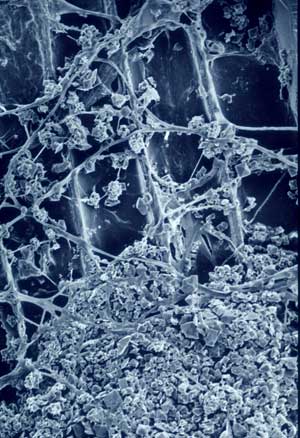
Scanning electron micrograph of Ceriporiopsis subvermispora mycelium on wood, Courtesy R. Blanchett, University of Minnesota.
Global conversion of organic carbon to CO2 with simultaneous reduction of molecular oxygen involves the combined metabolic activity of numerous microorganisms. The most abundant source of carbon is plant biomass, composed primarily of cellulose, hemicellulose, and lignin. Many microorganisms are capable of utilizing cellulose and hemicellulose as carbon and energy sources, but a much smaller group of filamentous fungi has evolved with the ability to depolymerize lignin, the most recalcitrant component of plant cell walls. Collectively known as white rot fungi, they possess the unique ability to efficiently depolymerize lignin in order to gain access to cell wall carbohydrates for carbon and energy sources. These wood-decay fungi are common inhabitants of forest litter and fallen trees. As such, white rot fungi play an important, if not pivotal, role in the carbon cycle.
White rot fungi vary in their ligninolytic selectivity. For examples, the model white rot fungus Phanerochaete chrysosporium simultaneously degrades lignin and cellulose, while Ceriporiopsis subvermispora rapidly depolymerizes lignin with relatively little cellulose degradation. The mechanism involved is poorly understood, although it is well established that the species secrete different types of oxidative enzymes. The annotated gene set of C. subvermispora, transcript patterns, and comparative analyses with the lignin-degraders P. chrysosporium and Pleurotus ostreatus will advance our understanding of these complex oxidative mechanisms involved in lignocellulose conversions.
Beyond lignocellulose conversions, white rot fungi have been extensively studied for their ability to transform and detoxify a wide range of xenobiotics, and C. subvermispora has figured prominently in a range of ‘pulp and paper’ applications.
Principal Investigators: Dan Cullen (USDA Forest Products Laboratory) and Rafael Vicuña (Universidad Católica de Chile).
Program: CSP 2009